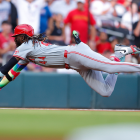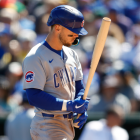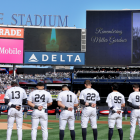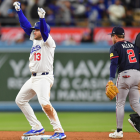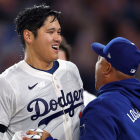On Friday, the New York Mets reportedly reached an agreement on a one-year contract worth $3 million with right-handed reliever Fernando Salas, according to Ken Rosenthal:
Source: #Mets bringing back free-agent reliever Fernando Salas. Deal will be pending physical.
— Ken Rosenthal (@Ken_Rosenthal) February 3, 2017
Later on, the Mets agreed to terms with lefty Jerry Blevins, per Jon Heyman:
Jerry Blevins has deal with mets
— Jon Heyman (@JonHeyman) February 4, 2017
Both are reasonable deals for the Mets, whose interest in adding middle-relief help had been established throughout the winter. Salas has carved a decent career for himself on the strength of his rising fastball and deceptive mechanics, and he pitched well for the Mets last season -- in 17 innings he posted a 2.08 ERA and struck out 19 batters without issuing a walk. Blevins, meanwhile, is one of the better left-handed specialists in the game.
The most interesting thing about the deals aren't the pitchers, however. Rather, it's how the Mets have gone all-in for 2017 by keeping most of their 2016 roster in place.
Throughout the winter, the Mets have chosen time and again to stick with what helped them reach last fall's Wild Card Game. Hence re-signing Yoenis Cespedes, Salas, and Blevins; hence exercising options held on Jose Reyes and Jay Bruce; and hence offering Neil Walker the qualifying offer (which he later accepted).
As Mike Axisa recently noted, the Mets have added external talent this winter through minor-league deals -- and that's it. No trades, no big-league free-agent signings from other teams. That's it.
Put simply, the Mets are banking on their roster earning better results this season than it did last. Is that a smart gambit? It depends on how you feel about health.
Ultimately, the issue with the 2016 Mets was they couldn't stay healthy -- especially when it came to the rotation. If the Mets can more from Jacob deGrom, Matt Harvey, and Zack Wheeler than last season (41 combined starts), then Sandy Alderson will look smart. If the Mets also receive more production from David Wright, Lucas Duda, and Travis d'Arnaud (612 plate appearances), then Alderson is a genius. (You can throw Bruce in there as well, though his issues were purely performance-related.)
Projecting health -- particularly for pitchers -- is one of the toughest things in baseball to do. The Mets themselves have a shaky history when it comes to evaluating their players' health, too, which doesn't inspire much confidence that this strategy will work.
Still, the Mets probably didn't have much of a choice. Cespedes and Walker were two of the best free-agent hitters available, and their budget didn't allow for much more than a middle-relief type or two.
That doesn't mean the Mets' choice will pay off -- the best-laid plans can and do go awry in this game -- but it does mean their offseason strategy has been reasonable, if largely boring.
![[object Object] Logo](https://sportshub.cbsistatic.com/i/2020/04/22/e9ceb731-8b3f-4c60-98fe-090ab66a2997/screen-shot-2020-04-22-at-11-04-56-am.png)












